#Kimjongilia
Explore tagged Tumblr posts
Text
The Story of a Blooming Flower on Letterboxd
A Japanese florist creates his masterpiece: the red begonia hybrids will represent the Juche ideology and stand as a symbol of love, justice and peace. In honor of the beloved leader, he gives her the name Kimjongilia.
1 note
·
View note
Photo

“Every winter has its spring.”
Please have this rare pic of him smiling.
@aphasiaweek
#hetalia#aph korea#hws korea#aph north korea#hws north korea#aph#hws#im sang kyu#circe draws#i went through several different ideas for this before settling on one i liked#and then i couldn't decide if he should be smiling or not#then i figured that since i went with the least happy color scheme he might as well get to smile#makes it bittersweet#those are kimjongilia btw
201 notes
·
View notes
Photo

Two children pose in front of a display at the exhibition of kimilsungia and kimjongilia flowers - named for North Korea’s former leaders. Pyongyang, North Korea.
37 notes
·
View notes
Video
youtube
when I was younger I had a stamp collection and had a north korean stamp with this flower and also a small musical score printed on the stamp. dunno how I got my hands on this particular stamp, but it was probably one of this big stamps released for collectors or something. Anyway, looking up the hangul in the position most likely to be the title of the melody, led me to this video. I didn’t double-check and compare the notes with the song, but here we are with some north korean music. do I have to mention that I don’t endorse the north korean dictatorship?
so yeah, this is song called Kimjongilia (김정일화), which is a flower named after, you guessed it, Kim Jong Il, the previous leader of North Korea. I don’t know who sang this tune. the russian description of the video tells us some stuff about the flower and that’s it. the lyrics on wikipedia seem rather harmless, the usual propaganda music stuff, and what I got from typing in some of the lyrics on screen into google translate (note: I never learned korean) seems rather harmles as well (”we miss you in our hearts, on the red mountain something something”). I stumbled on a hangul sign I didn’t know how to type, so I lost interest.
1 note
·
View note
Photo

SOCIALIST REALISM AND THE ART OF PROPAGANDA
The artistic style and movement of socialist realism goes hand in hand with propaganda. Above we see a North Korean socialist realist depiction of the glory of the regime and the veneration of the proletariat.
The Tate Modern in London defines the art term, movement and style of socialist realism: “The doctrine was formally proclaimed by Maxim Gorky at the Soviet Writers Congress of 1934, although not precisely defined. In practice, in painting it meant using realist styles to create highly optimistic depictions of Soviet life. Any pessimistic or critical element was banned, and this is the crucial difference from social realism. It was quite simply propaganda art, and has an ironic resemblance to the Fascist realism imposed by Hitler in Germany (see Entartete Kunst – degenerate art). Outside the Soviet Union, socialist artists produced much freer interpretations of the genre as the paintings on this page illustrate.”
Another great article from ArtNews entitled “A Second Life for Socialist Realism: European Museums Revise the History of Socialist Realism” is fantastic further reading on how the style and movement is and was so very important to disseminating and communicating government propaganda visually.
This painting by Marsel Van Oosten captures the exaltation of liberation and extols the virtues of the Soviet army in freeing Berin from the Nazi regime only to later suppress the nation, the eastern bloc an promote communist ideologies which were to take hold in East Germany and East Berlin throughout the next few decades.

This article in The Independent reviewing a 2015 exhibition in China entitled “Art of the state: Pyongyang propaganda posters to be exhibited in China” features some fantastic North Korean propaganda and socialist realism posters. The posters feature brilliant color and impeccable understanding of graphic design as it pertains to communicating the party line visually.
This below poster reads in Korean: “‘Love our machines like the anti-Japanese guerrillas who loved their weapons like the pupils of their own eyes’ (1990s)”
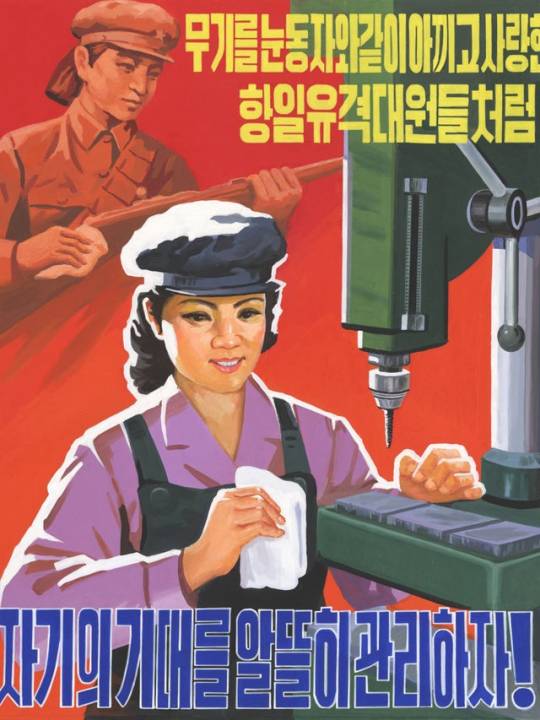
This below piece of North Korean propaganda is a poster designed to foster anti U.S. sentiment and directs the country to “crush U.S. Imperialism!”
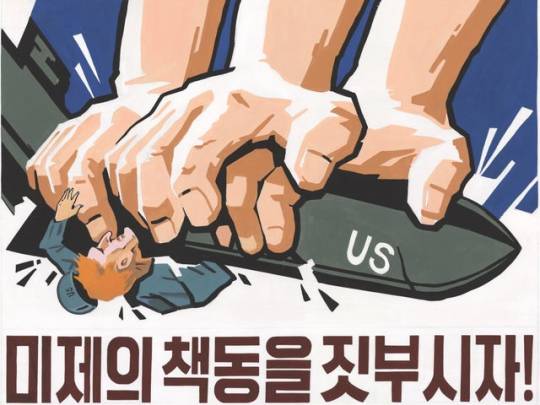
The following poster featuring a railway worker below reads ‘Three revolutions, let’s advance the march of grand construction with Chollima [a mythical winged horse or Pegasus] speed’ (late 2000s)
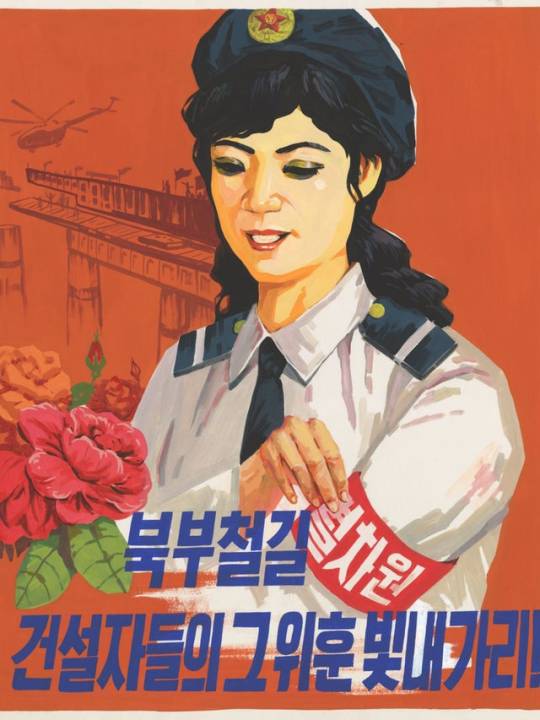
The above poster referenced the building of the new railways and features the worker holding a Kimjongilia flower that represents the dear leader Kim Jong-il.
A personal approach to propaganda:
As my family is Hungarian and was displaced at the hands of the incoming Soviet regime, my great grandfather Ferenc Nagy was forced to resign from the role of prime minister in 1947 for refusal to become a communist leader. This led to a puppet Soviet leader being installed until the “election” at the end of this term. The Budapest Poster Gallery is a gallery in Budapest and a treasure trove of vintage posters and the gallery exhibits and specializes in fine Hungarian vintage posters, propaganda posters and commercial graphic design from between 1890 and 1990. They write of this era of propaganda posters:
“The election in 1949 was the starting point of a new, dictatorial era. In the same year, a new constitution was written, which provided a strong basis for the communist regime. The power of the working class was supposed to be represented by the strong dictatorship of the Hungarian Workers’ Party, and its leader, Mátyás Rákosi. Meanwhile, the country was under the occupation of the Russian red army which took every aspect of the life of Hungarians under its control. These were the darkest years of communism, when the economy went thorugh a disastrous downfall and human rights were trampled. The period of this forceful dictatorship was ended by the revolution of 1956. Although the uprising did not manage to totally strike down the communist leadership, as a result of the extensive international awareness it had raised, the system slowly started to get softer, but only after the terrible initial retaliations following the revolt. ”
A poster by Istvan Czegledi reads: “Be the member of the Hungarian - Soviet Association!:
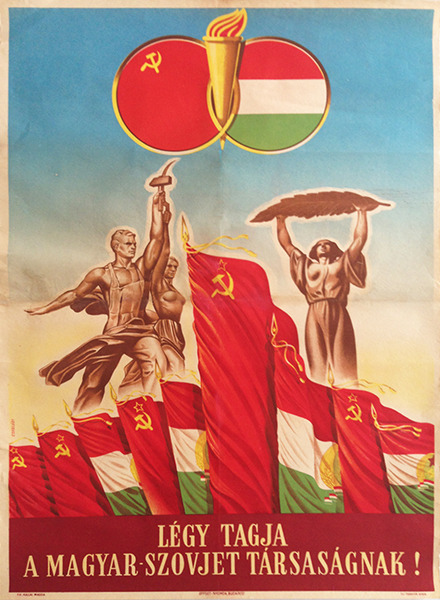
The Budapest Poster Gallery writes of the significance of this socialist realist movement and how restrictive it was upon artists, graphic designers and the arts in general and what could be communicated visually and how:
“The themes of painting were also restricted; they were mostly scenes from the workers’ idealized lives. In the 1930s and 1940s, there was a realist tendency present in Hungarian poster art. For example, Tibor Gönczi-Gebhardt designed posters with plastic and monumental forms, and simple political symbols. This tradition gained ground in the 1950s, because it matched the expectations of the new regime. The revolutionary modern poster design of the short democratic period between 1945 and 1949 rapidly vanished. The principles of the rigid and ceremonial soviet poster design became the guidelines for Hungarian artists. This change meant the near exclusivity of socialist realism. Photo-like realistic human figures appeared on the posters, who were mainly idealized typical characters: smiling workers, proud peasants, housewives and children with theatrical gestures, standing straight with their heads up, staring into the distance. They are often marching or working at factories, mines, or wheat fields, laying the foundation of the bright future.
The Magyar Nemzeti Galéria or the Hungarian National Gallery features this visually striking propaganda poster in their collection from 1948 by Gönczi-Gebhardt Tibor advertising the sham “unification congress” of the two parties combining into the Hungarian Socialist (Communist) Party and is reminiscent of the art-deco style:
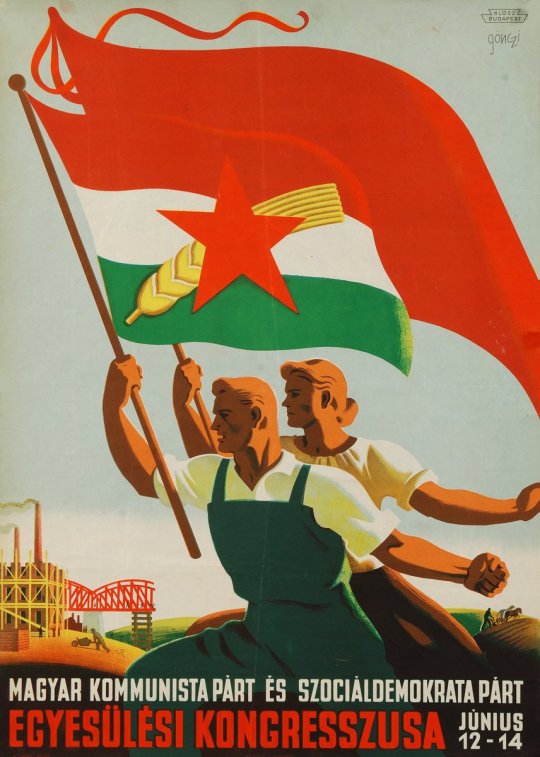
1 note
·
View note
Photo


Kimilsungia - Kimjongilia
https://steemit.com/history/@thereliye/is-it-true-that-north-korean-national-flowers-feel-from-indonesia-e009859f8ba9c
https://www.youtube.com/watch?v=-5Y_Ak3t7Ps
Why Doesn’t Kim Jong-un Have One?
0 notes
Link
0 notes
Photo








Socialist Korea: Birth Anniversary of Kim Jong Il Celebrated
Pyongyang, February 16 (KCNA) -- Service personnel and people of the DPRK celebrated the birth anniversary of leader Kim Jong Il (the Day of the Shining Star) with splendor.
An endless stream of people visited the Kumsusan Palace of the Sun, the sacred temple of Juche, where President Kim Il Sung and leader Kim Jong Il lie in state.
They paid tribute to the portraits of smiling Kim Il Sung and Kim Jong Il at the plaza of the palace.
Service personnel and people from all walks of life and youths and students visited the statues of the great leaders and portraits of the smiling great leaders on Mansu Hill and in different parts of the country to pay tribute to them.
People also visited the venue of the 21st Kimjongilia festival here and Kimjongilia exhibition halls in each province with yearning for him.
People from all walks of life went round the venues of the photo shows on his revolutionary history.
Art performances were given at theatres here and in other parts of the country.
A drama "Blood Vessel" was given at the National Theatre.
Magicians gave performances at the Magic Theatre of the National Acrobatic Troupe.
Artistes across the country gave colorful performances.
Art performances were also given at the construction sites and various industrial establishments and on different farms.
Pupils across the country joined the Korean Children's Union.
9 notes
·
View notes
Photo

🥀 //; Kimjongilia
I drew this as vent art but it actually came out looking okay.
Bloody version below.

#hetalia#aph#hws#aph north korea#aph korea#hws north korea#hws korea#tw blood#tw injury#tw eye injury#im sang kyu#circe draws#aph oc#hws oc
396 notes
·
View notes
Text
North Korea’s 2020 flower calendar omits propaganda flowers
Many North Koreans were surprised to find that a recently published North Korean calendar omitted the images of the Kimilsungia and Kimjongilia, two flowers traditionally used to mark the birthdays of former leaders Kim Il Sung and Kim Jong Il. Most North Korean publishing companies have printed images… North Korea’s 2020 flower calendar omits propaganda flowers published first on https://yeuhoavn.tumblr.com/
0 notes
Text
Cuộc sống bình yên ở Triều Tiên
https://otavietnam.com/?p=29211 Cuộc sống bình yên ở Triều Tiên Quốc gia nổi tiếng “bí ẩn nhất thế giới” yên bình dưới ống kính của nữ nhiếp ảnh gia, nhà báo Afghanistan. Cuộc sống bình yên ở Triều Tiên Emma Graham-Harrison, nữ nhà báo sống ở Kabul, Afghanistan, có chuyến thăm Triều Tiên cuối năm 2018. Trong chuyến du lịch này, cô đã ghi lại những khoảnh khắc yên bình trong cuộc sống của quốc gia được mệnh danh là “bí ẩn nhất thế giới này”, theo Guardian. Phần lớn bức ảnh đều được nữ du khách chụp ở thủ đô Bình Nhưỡng, trung tâm chính trị, kinh tế, xã hội của Triều Tiên. Hình ảnh chủ tịch Kim Nhật Thành và Kim Jong-il xuất hiện ở nhiều địa điểm công cộng, được người dân tôn kính. Du khách xếp hàng chờ đợi để tới lượt vào tham quan nơi sinh của cố chủ tịch tại Mangyongdae, Bình Nhưỡng. Đối với người Triều Tiên, đây như một địa điểm hành hương để thể hiện lòng tôn kính đối với lãnh tụ. Ba người đàn ông chèo thuyền trên sông Đại Đồng (Taedong) chảy qua thủ đô Bình Nhưỡng. Dọc theo bờ sông là những công trình nổi bật khách tham quan thường ghé thăm như tháp Chủ Thể (Juche) và quảng trường Kim Nhật Thành. Một cô dâu chụp ảnh cưới ở núi Moran. Những hành khách đang đợi tàu điện ngầm khởi hành. Một gia đình đưa con đi ăn hàng vào dịp cuối tuần vô tình lọt vào ống kính của nữ du khách. Quán cà phê này nằm bên trong bảo tàng Lịch sử Tự Nhiên, thuộc sở thú Bình Nhưỡng. Công nhân đang dọn dẹp và sửa chữa khu vực bên ngoài của công viên nước Munsu, chuẩn bị đón khách vào mùa hè tới. Hai em bé chụp ảnh trong triển lãm hoa kimilsungia và kimjongilia. Đây là hai loài được đặt theo tên của các nguyên lãnh đạo của Triều Tiên. Khách tham quan chụp ảnh lưu niệm trong công viên núi Moran. Theo Anh Minh/Vnexpress Cẩm nang du lịch iVIVU.com iVIVU.com February 22, 2019 Bởi - https://otavietnam.com/?p=29211
0 notes
Link
One of the closest things to an example of American culture in Pyongyang is the Green Leaf Coffee Shop — the top burger joint in the North Korean capital.
Across the road from the April 25 Culture House — named for the day the North’s founder Kim Il Sung set up anti-Japanese guerrilla forces — it overlooks the showpiece Ryomyong Street development his grandson and current leader Kim Jong Un opened in 2017.
The 1970s-style decor is predominantly brown, pictures of the Kimilsungia and Kimjongilia flowers named for the North’s rulers are on show, and footage of the State Merited Chorus plays on a television.
A basic beefburger costs slightly less than $2, while a cheeseburger with minced beef and bacon is around $4.
In a nod to local tastes, it also offers burgers with kimchi, and some with the bun replaced by two layers of rice, among other dishes.
The burgers come wrapped in paper on plastic trays, the chips in red cartons echoing McDonald’s, albeit served by uniformed waitresses.
But the isolated North has long seen the United States as its implacable enemy, blaming it for the division of the Korean peninsula, countless atrocities during the Korean War, and its economic struggles.
In the run-up to Kim Jong Un’s summit in Hanoi with US President Donald Trump, the nuclear-armed North’s official media barely mentioned the meeting.
The burger restaurant’s founders — it was set up by a Singaporean businessman, Patrick Soh, who operated a franchise of the US chain Waffletown in the Lion City — avoided American connotations.
They called it Samtaesong, which Soh translates as “three big stars”, and it has since been renamed again, with the menus now describing it as owned by the Sogwang High-Tech Corporation.
The clientele is mostly small family groups and young couples, and manager Kim Yong Ae says the 300 to 500 customers a week do not think of burgers as American.
“We brought it from Singapore’s Waffletown, so people know it just as hamburgers, a form of layered bread, rather than McDonald’s,” she told AFP.
“Some think of it as Singaporean food.”
Rictus of hate
North Korean authorities teach their citizens from birth to despise the US, with war museums depicting white soldiers slaughtering innocent civilians, their gnarled faces twisted into rictuses of hate.
One memorial site in Sinchon — where US forces are said to have massacred more than 35,000 people, although foreign researchers say the toll is unclear and there is no evidence of American culpability — features a “revenge-pledging place” where busloads of visitors can hurl abuse at the US.
“People are influenced in multiple ways by those narratives, even if not everyone buys it wholesale,” said Sokeel Park of Liberty In North Korea, which helps defectors travel from China to third countries.
“There are some alternative sources of narrative about the US,” he added.
Pyongyang closely controls all media in the country, but illicit content circulates on USB sticks, watched in secret by citizens who face criminal punishment for doing so.
Most of it is Korean-language rather than foreign, according to observers, but Park said some US films had entered the country — American music less so — and some people listened to Radio Free Asia and Voice of America broadcasts.
After the vitriol of 2017, when the two countries’ leaders traded personal insults and threats of war, the official KCNA news agency’s tone has adapted alongside the diplomatic drive, offering few overt criticisms of the US or Trump and instead reserving its bile for former colonial overlord Japan.
Pyongyang did nothing to shy away from covering the first summit in Singapore, portraying Kim and Trump meeting as equals.
And an about-turn in the relationship would not “cause the cognitive dissonance that many people expect it would”, according to Simon Cockerell, general manager of specialist travel agency Koryo Tours, who has been to the North 176 times over 17 years.
The North Koreans he has spoken to, Cockerell says, are “all pretty uniformly against the US government as you might expect”, but “have the nuance to not identify the entire US population as their enemy”.
And they were “mentally flexible and intelligent enough to understand and adapt to the message changing while still internalising the core belief: that the US is the enemy of the DPRK and will be until the most basic agreements are reached, then things may change!”
The post Do you want fries with your North Korea-US summit? appeared first on ARYNEWS.
https://ift.tt/2U5YbCt
0 notes
Text
North Koreans unhappy with excess celebration of late leader's birthday
The 23rd Kimjongilia Festival from Feb. 14 to 21 in the North Korean capital of Pyongyang is expected to display the flower named after the current leader's late father and celebrate his Feb. 16 birthday, known as the Day of the Shining Star. But that is excessive even by some North Koreans' standards, according to Radio Free Asia, a U.S.-funded multi-language media outlet. “Unlike ordinary plants, Kimjongilia needs more than 15 hours of light and is a particularly sensitive plant in terms of temperature, so even if we succeed in making it bloom in cold weather like now, it easily falls off in a day or two,” a source in the North's South Pyongan Province told RFA on condition of anonymity. from The Korea Times News http://bit.ly/2SIOmgu via IFTTTDiigo Blogger Tumblr Evernote
0 notes
Video
north korea - arirang or mass games 2011 출처: retlaw snellac Flickr를 통해: Arirang Festival mass games display in Pyongyang on Republic Foundation Day 9 september 2011. The Grand Mass Gymnastics and Artistic Performance Arirang are held in the Rungrado May Day Stadium in Pyongyang, North Korea. The two-month gymnastics and artistic festival celebrates the birthday of Kim Il-sung (15 April). The festival has been held from August until October since 2002-2005, and 2007 until the present. The Mass Games possess an important ideological character praising the Workers Party of North Korea, its armed forces, Kim Il Sung and Kim Jong Il. These messages may not be clear to foreign spectators who are not aware of North Korean iconography: a rising sun symbolizes Kim Il Sung. When a gun is shown, it signifies the gun which Kim Il Sung gave to his son Kim Jong Il. The color red, particularly in flowers, stands for the working class. And the color purple and purple flowers represent Kim Il Sung (as the flower 'Kimilsungia is a purple orchid and the flower 'Kimjongilia' is a red begonia). A snowy mountain with a lake represents Mount Paektu where Kim Jong Il is said to have been born in a log cabin. From as young as 5 years old, citizens are selected based on skill level to serve for the Arirang Festival for many years. In most cases this will be the way of life for them until retirement. The opening event of the two month festival are the mass games, which are famed for the huge mosaic pictures created by more than 30,000 well trained and disciplined school children, each holding up coloured cards, in an event known in the West as a card stunt, accompanied by complex and highly choreographed group routines performed by tens of thousands of gymnasts and dancers.
0 notes
Link
0 notes